Source
Struggling to effectively allocate your advertising budget on YouTube? Want to ensure every dollar you spend on YouTube ads is working toward achieving your goals?
In this article, you’ll discover how to develop a YouTube ads budget that maximizes your ROI.
As with any digital advertising platform, though, the actual cost of a campaign can depend on several factors. The campaign objective has a significant impact on the total cost. YouTube ad quality is another key factor, as are audience targeting and bid strategy.
As a general rule, a YouTube campaign with a bottom-of-funnel objective (i.e., sales) will cost more than a campaign of comparable quality with a top-of-funnel objective (i.e., brand awareness). When budgeting for YouTube ads, it’s important to consider the probable cost of the objective along with the ROI the campaign is likely to deliver.
As an example, the YouTube campaigns below reflect two different objectives and bid strategies. The top campaign uses a consideration objective with a view-focused bid strategy, while the bottom campaign uses a conversion objective with a sales-focused bid strategy.

So which video campaign cost more? Technically, the bottom campaign had a higher cost but it also had a higher ROI, a higher click-through rate (CTR), and a lower cost per click (CPC). In comparison, the top campaign had a lower cost but generated more impressions and views.
YouTube recommends starting with a budget of at least $10 to $50 per day. When working with new accounts or new ad types, I typically aim for a budget of about $16.50 per day, which equals about $500 per month. Once I find what works, I can easily scale up the spend while improving the ROI.

Use the workflow below to start testing YouTube ads and benchmarking campaign costs. Then continue to optimize your bid strategy and campaign budget to increase ROI.
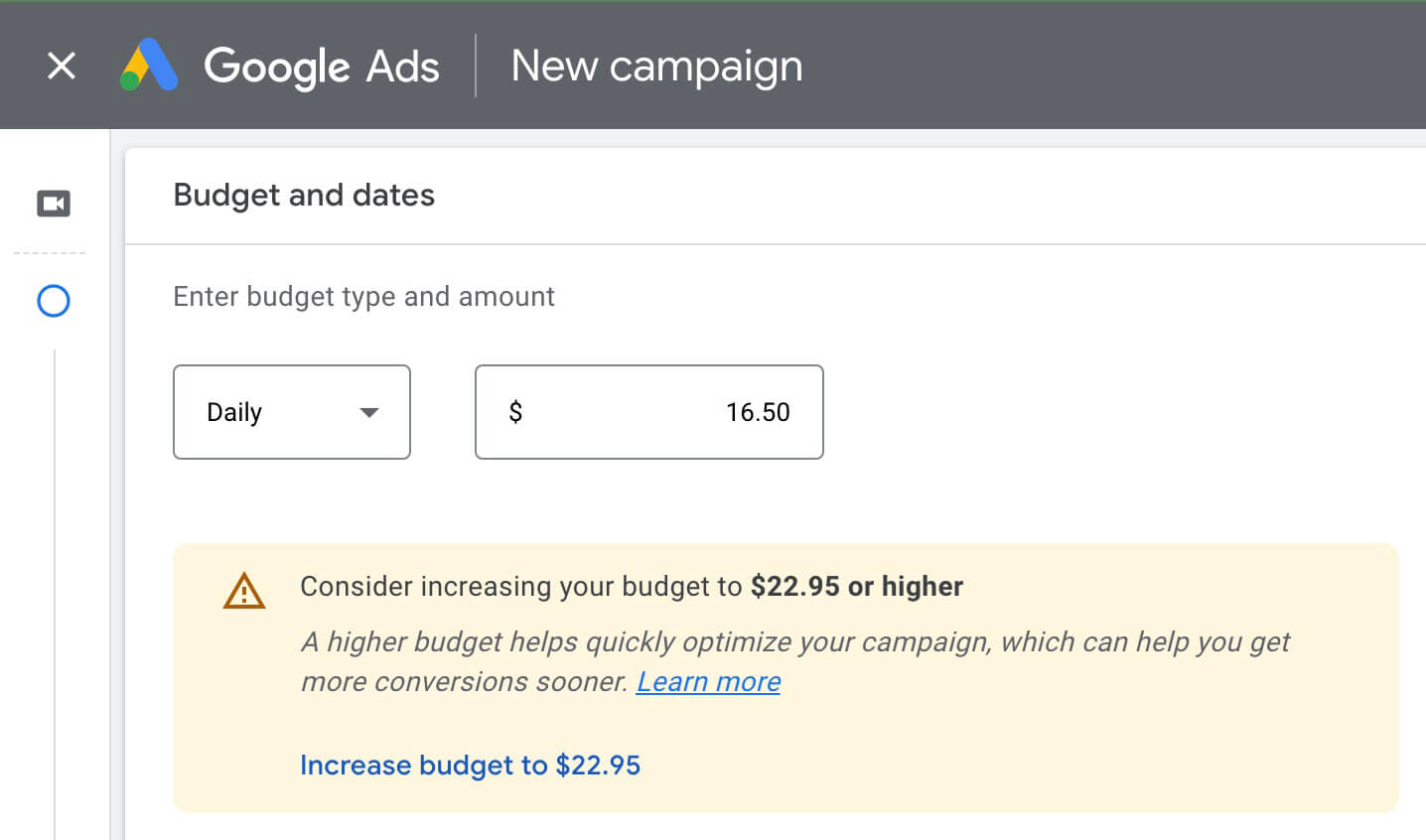
To get the total campaign budget, multiply your average daily spend by the total number of days you plan to run the campaign. As a general rule, you should plan to run YouTube ad campaigns for at least 2 weeks—and much longer if possible.
The Google Ads learning phase can last up to a week, which means performance may not stabilize for several days. If you want to benefit from optimized campaigns or scale successful campaigns, plan on a much longer timeframe.
Then choose a bid strategy from the list of options. Note that if you choose a bid strategy that requires manual input, Google Ads will recommend a typical bid range, which you can use as a starting point. Once you gather enough data from your YouTube ads, you can change the bid as necessary.
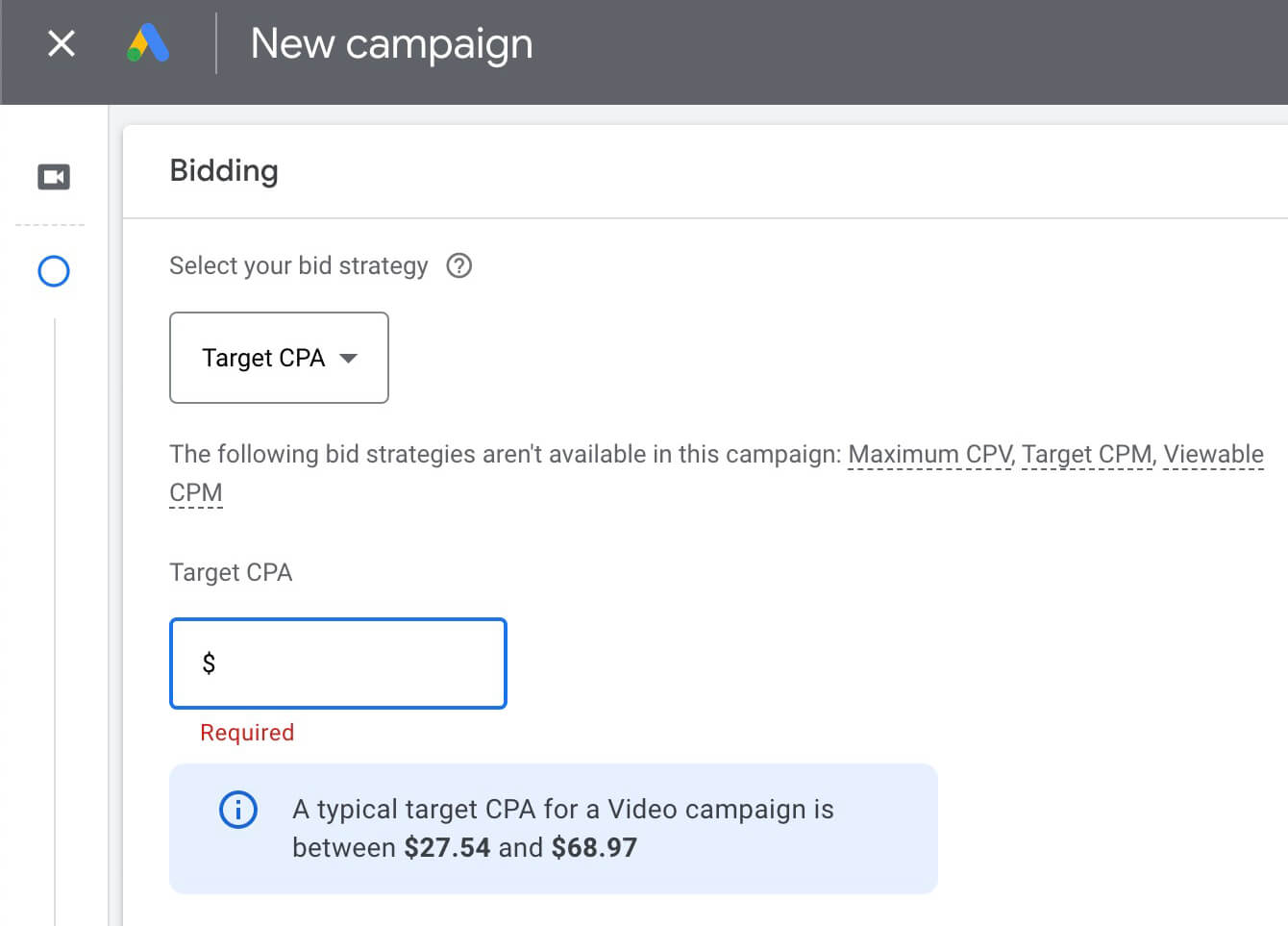
How do you know when to change the bid? Look for a campaign with an average CPV that’s much lower than the maximum CPV bid you set. Review performance over time to confirm that the average CPV and views have remained steady.
Then click the pencil icon to change the bid so it’s closer to the average CPV results you’re seeing. For example, the campaign below has a maximum CPV of $.25 and an average CPV of $.01 with steady views and costs over several weeks, making it a great candidate for a lower maximum CPV bid.
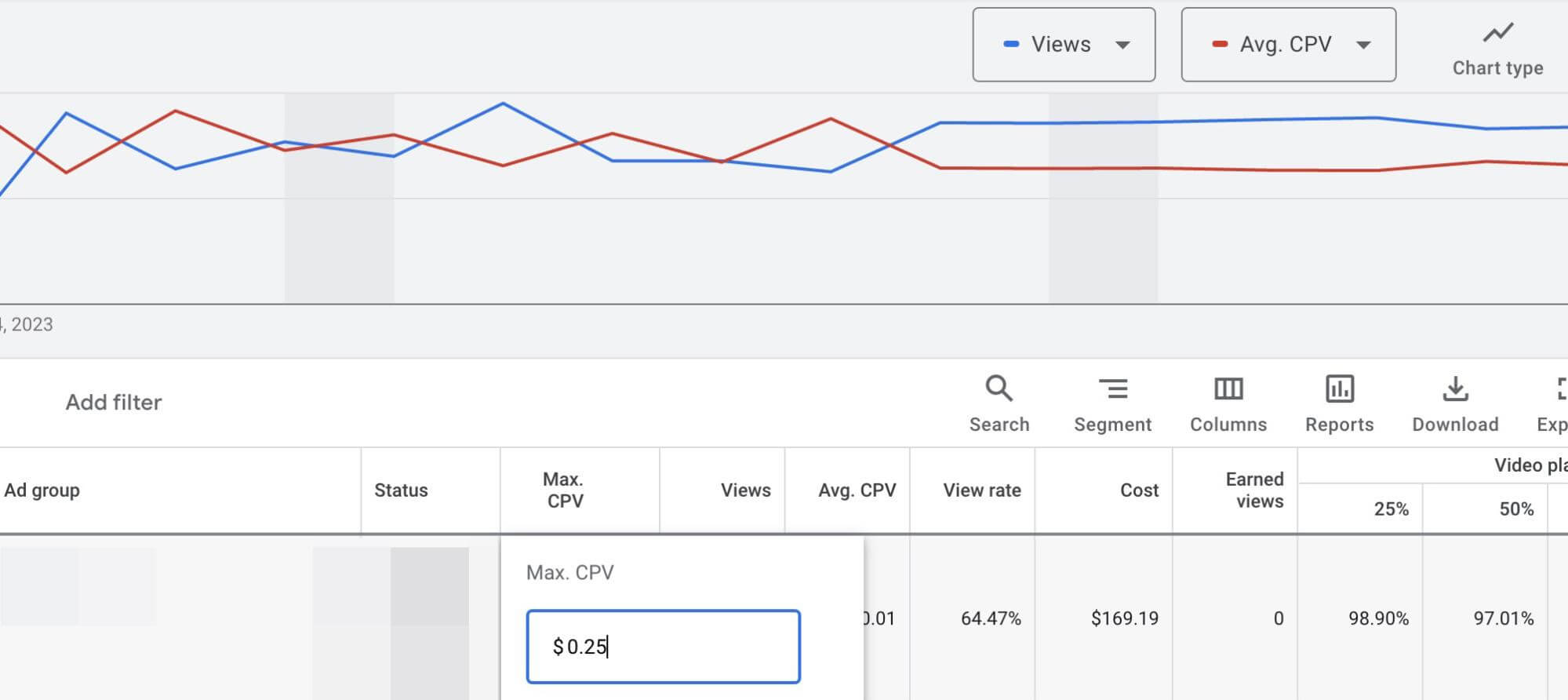
Note that changing YouTube ad bids can send the ad group back to the learning phase. To avoid restarting the learning phase repeatedly, update bids as infrequently as possible—ideally, no more than twice a month and never when the ad group displays an Eligible (Learning) status.
Just make sure that the campaign you’re referencing and the one you’re building use the same Google Ads objective. Otherwise, the cost metrics may not be relevant and could lead to ineffective bids.
You can also use data from recent or active campaigns to build new YouTube ads that give you more control over how much you spend. For example, YouTube video conversion campaigns (i.e., those that use the website traffic, leads, or sales objective) give you multiple bid strategy options.
If you use maximize conversions, you can collect a ton of data while Google Ads automates bidding to achieve as many conversions as possible. With that data, you can pinpoint the average cost per conversion for your offer. Then you can use that number to set a target CPA (cost per action) for a new campaign.

Although both maximize conversions and target CPA are smart bidding options, target CPA gives you much more control over your results. With this bid strategy, you can optimize campaign performance while keeping costs in check and zeroing in on a specific ROI goal.
Whether you choose skippable, non-skippable, or bumper ads, you only have a few seconds to get viewers’ attention. To do that effectively, focus on starting your YouTube ads with a hook that speaks to viewers and captures their interest.
Suspect that your creatives are compromising campaign ROI? Consider using the video ad templates in the Google Ads asset library. These templates may seem simple but they’ve been tested to perform in YouTube ads.
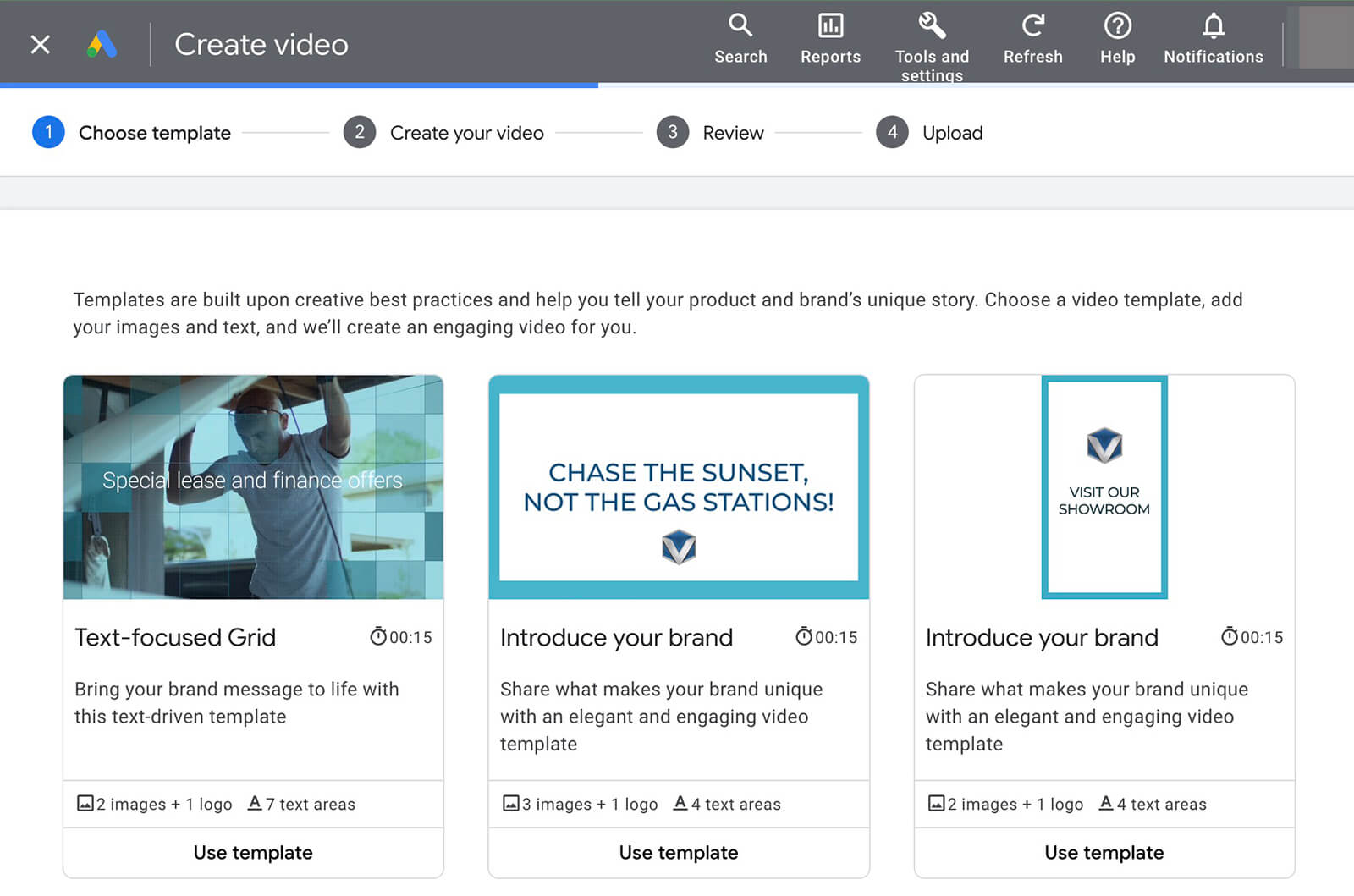
To use these templates, open the asset library in Google Ads and choose to create a new video. Scroll through the templates to find one that aligns with your goals and click to start creating. Then add the required assets, choose an audio track, and use the final product in your ad.

Note that most ad groups support multiple YouTube ads. For optimal ad delivery and maximum ROI, make sure to include at least three video ads in each ad group. That way, you can avoid ad fatigue and learn more about what works best for your audience.

Keep in mind that the closer you get to the bottom of the funnel, the fewer options you have for detailed targeting. As of early 2023, Google Ads no longer allows video conversion campaigns to use content-based targeting. That means you can’t target by keyword, creator, or topic.
Google Ads automatically applies optimized targeting to video conversion campaigns, using your assets and landing page to deliver your ads effectively. However, you can add new or existing audience segments to assist with optimization.

Here are a few ways to leverage audience segments:

So should you focus on top-of-funnel objectives where YouTube ads excel or aim for bottom-of-funnel objectives designed to drive the highest ROI? For optimal results, you should plan to do both.
Like most digital advertising platforms, Google Ads delivers the optimal results when you run full-funnel campaigns. In fact, an internal Nielsen study found that a full-funnel YouTube ads strategy led to 10% higher ROI.
Depending on your business goals, a full-funnel campaign might include using brand awareness and reach, product and brand consideration, and sales objectives. Or it might include using brand awareness and reach, website traffic, and leads objectives.
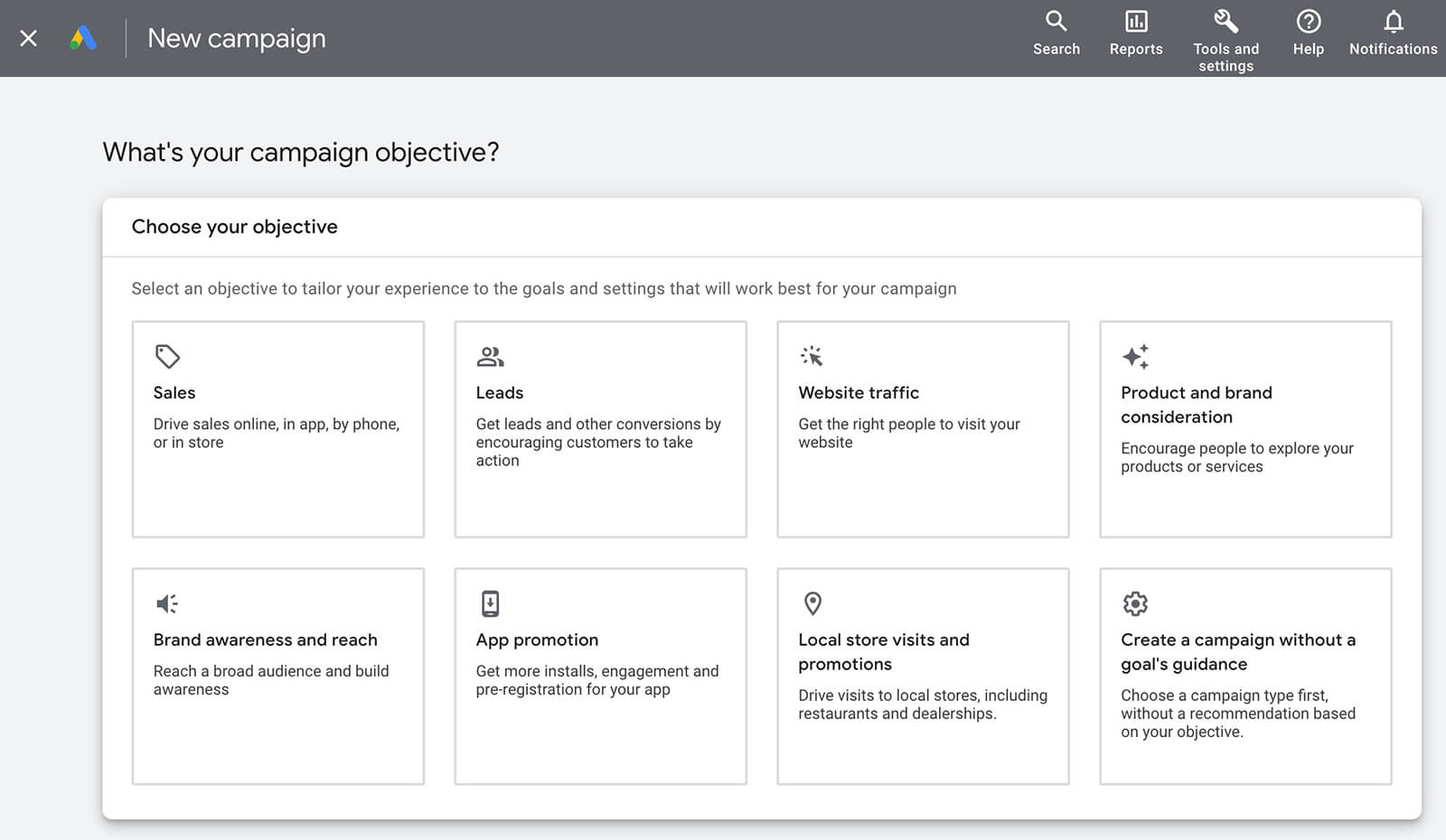
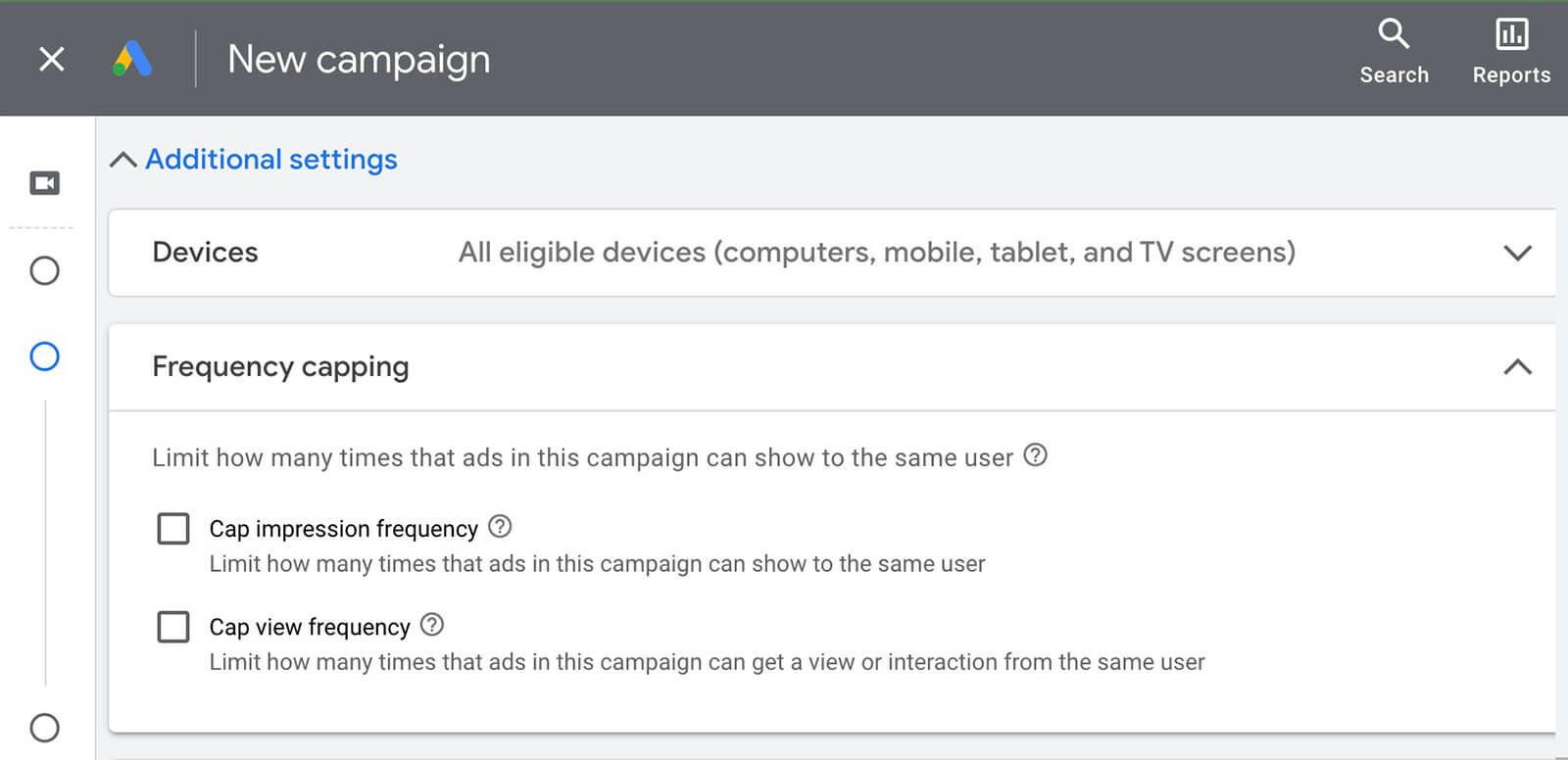
Campaigns using the brand awareness and reach objective give you even more control over frequency. During the campaign setup workflow, you can choose Target Frequency as the way you want to reach your goal. Then you can set a weekly target (between 2 and 4) to ensure you reach viewers the optimal number of times.

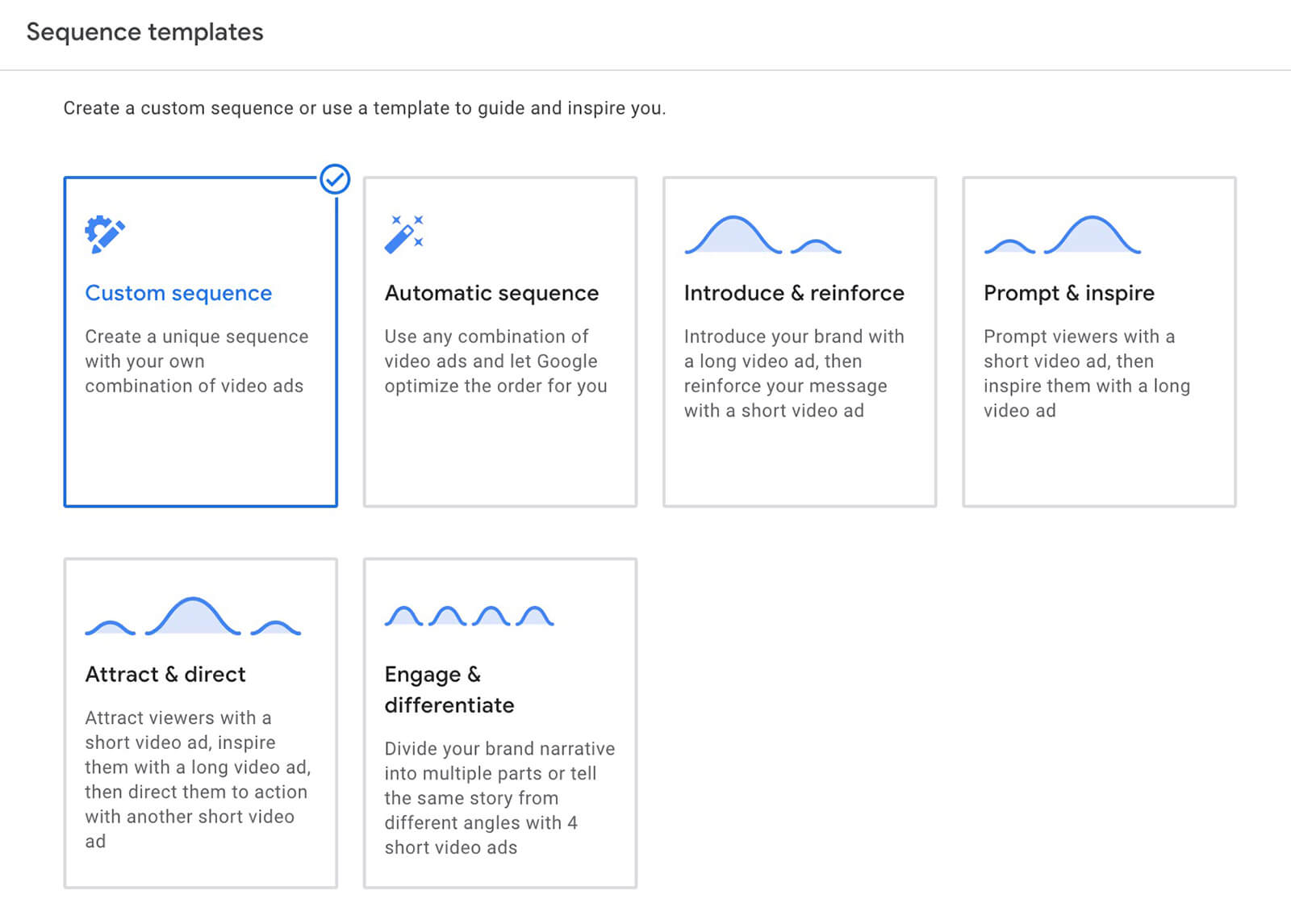
You can choose this option in the campaign setup workflow if you choose the product and brand consideration objective. Then you can choose a relevant sequence template for your campaign and choose between two and four ad creatives.
Another way to experiment with placements is to use Google Ads’ discovery campaign option. This campaign type works with middle- and bottom-of-funnel objectives, and it delivers ads across Google properties like YouTube and Gmail.
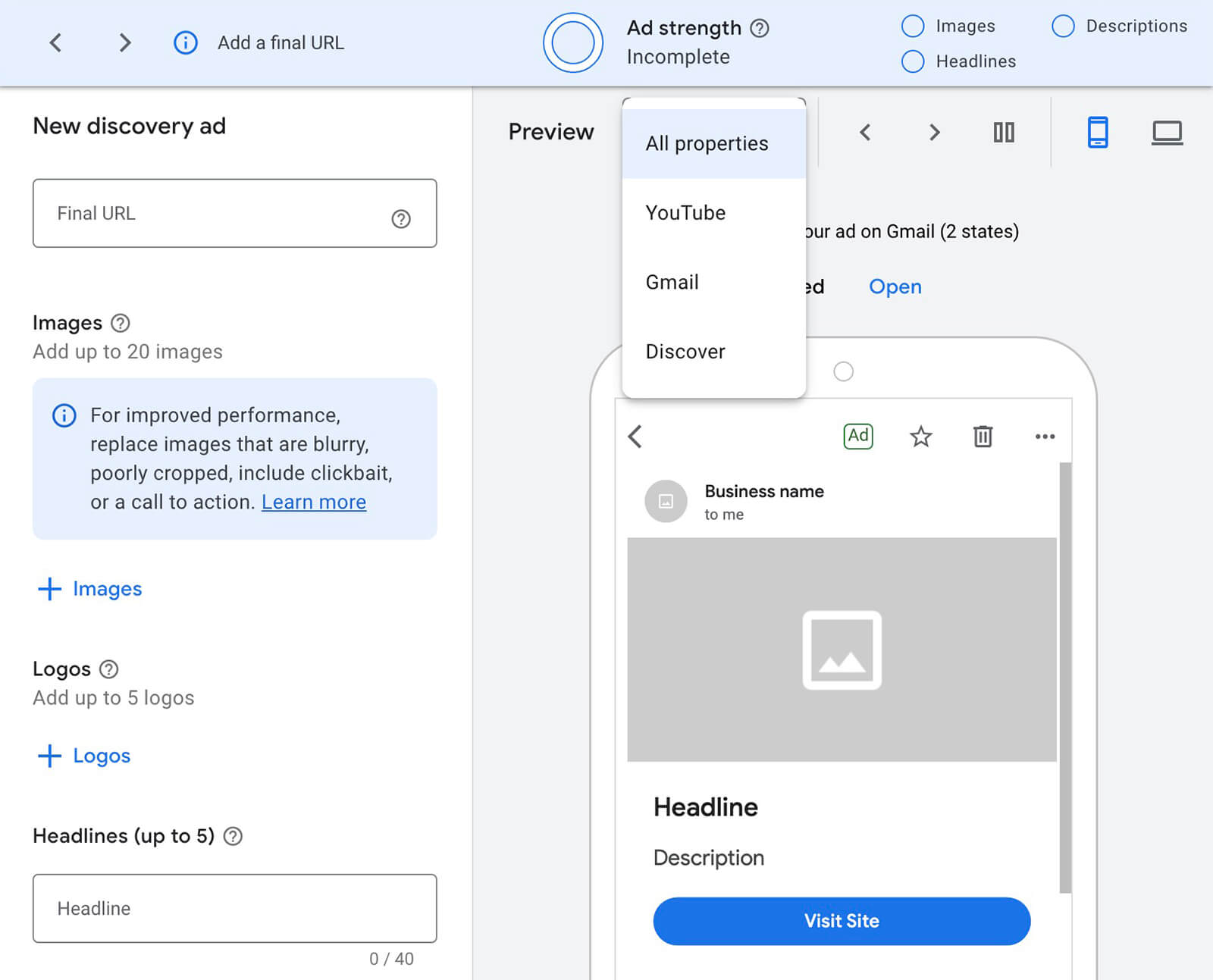
Because discovery campaigns place ads on YouTube as well as on properties like Gmail and Discover, they don’t support videos at all. For these campaigns, plan to add images and write ad copy.
But how should you approach campaigns that far outperform KPIs? Once you’ve identified a top-performing campaign, you can scale it by increasing the daily budget. While most digital advertising platforms restart the ad group’s learning phase after budget changes, Google Ads doesn’t. That means you can scale as rapidly as your budget allows.
Pay attention to Google Ads’ recommendations for your campaigns. The platform automatically recommends budget increases to help you optimize campaigns and drive more results.
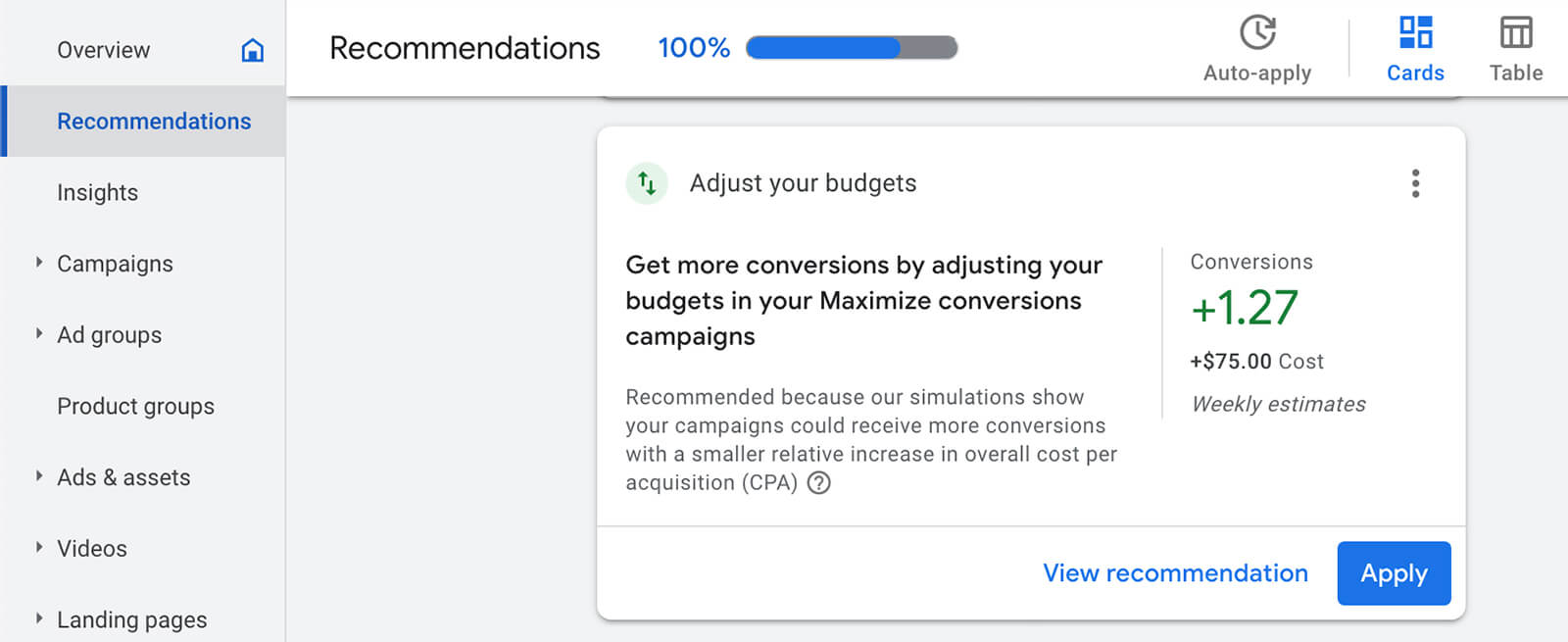
You can also scale YouTube ads by giving them more opportunities to deliver. You can broaden audience targeting, expand or remove content targeting, or add more creatives to scale campaigns horizontally.
With tools like YouTube Studio and Google Analytics, you can identify the content that performs best and the audience segments that respond most effectively and incorporate them into your YouTube ad campaigns.
Struggling to effectively allocate your advertising budget on YouTube? Want to ensure every dollar you spend on YouTube ads is working toward achieving your goals?
In this article, you’ll discover how to develop a YouTube ads budget that maximizes your ROI.
How Much Do YouTube Ads Cost?
On average, YouTube ads’ cost per thousand impressions (CPM) is between $4 and $10 and around $.20 per view, according to LocaliQ. Based on these numbers, you can map out an estimated budget for a YouTube advertising campaign.As with any digital advertising platform, though, the actual cost of a campaign can depend on several factors. The campaign objective has a significant impact on the total cost. YouTube ad quality is another key factor, as are audience targeting and bid strategy.
As a general rule, a YouTube campaign with a bottom-of-funnel objective (i.e., sales) will cost more than a campaign of comparable quality with a top-of-funnel objective (i.e., brand awareness). When budgeting for YouTube ads, it’s important to consider the probable cost of the objective along with the ROI the campaign is likely to deliver.
As an example, the YouTube campaigns below reflect two different objectives and bid strategies. The top campaign uses a consideration objective with a view-focused bid strategy, while the bottom campaign uses a conversion objective with a sales-focused bid strategy.

So which video campaign cost more? Technically, the bottom campaign had a higher cost but it also had a higher ROI, a higher click-through rate (CTR), and a lower cost per click (CPC). In comparison, the top campaign had a lower cost but generated more impressions and views.
How Much Should You Budget for YouTube Ads?
If you’re just starting to advertise on YouTube, it’s a good idea to allocate a relatively small test budget. That way, you can collect data while experimenting with campaign objectives and ad creatives without wasting the entire month’s budget on a week of Youtube advertising costs.YouTube recommends starting with a budget of at least $10 to $50 per day. When working with new accounts or new ad types, I typically aim for a budget of about $16.50 per day, which equals about $500 per month. Once I find what works, I can easily scale up the spend while improving the ROI.

Use the workflow below to start testing YouTube ads and benchmarking campaign costs. Then continue to optimize your bid strategy and campaign budget to increase ROI.
#1: Set YouTube Ad Campaign Goals
First, decide on an objective for your YouTube ad campaign. Then set a goal that aligns with the campaign objective. As an example, for a website traffic campaign, target a certain number of clicks. For a brand awareness campaign, aim for a certain number of impressions.#2: Launch Test YouTube Ad Campaigns
Next, set up a test campaign with a budget of as little as $10 per day. However, Google Ads may suggest a different starting budget for your campaign depending on the objective and other factors. In the example below, Google Ads recommends a daily budget of at least $22.95 for a website traffic campaign.
To get the total campaign budget, multiply your average daily spend by the total number of days you plan to run the campaign. As a general rule, you should plan to run YouTube ad campaigns for at least 2 weeks—and much longer if possible.
The Google Ads learning phase can last up to a week, which means performance may not stabilize for several days. If you want to benefit from optimized campaigns or scale successful campaigns, plan on a much longer timeframe.
Then choose a bid strategy from the list of options. Note that if you choose a bid strategy that requires manual input, Google Ads will recommend a typical bid range, which you can use as a starting point. Once you gather enough data from your YouTube ads, you can change the bid as necessary.

YouTube Ads Bid Strategies: How to Optimize Bids
A little optimization can go a long way, no matter which bid strategies your YouTube campaigns leverage. Use the recommendations below to adjust bids and get better results from your YouTube ads.#3: Modify Existing Bids
With some smart bidding strategies, you won’t have an option to adjust how much you bid per result. But with bid strategies like maximum CPV (cost per view), you can manually update the bid as necessary to keep your YouTube ads as competitive as possible.How do you know when to change the bid? Look for a campaign with an average CPV that’s much lower than the maximum CPV bid you set. Review performance over time to confirm that the average CPV and views have remained steady.
Then click the pencil icon to change the bid so it’s closer to the average CPV results you’re seeing. For example, the campaign below has a maximum CPV of $.25 and an average CPV of $.01 with steady views and costs over several weeks, making it a great candidate for a lower maximum CPV bid.

Note that changing YouTube ad bids can send the ad group back to the learning phase. To avoid restarting the learning phase repeatedly, update bids as infrequently as possible—ideally, no more than twice a month and never when the ad group displays an Eligible (Learning) status.
#4: Use Data for New Campaigns
The more YouTube advertising data you collect, the easier it will be to set up new campaigns successfully. For example, you can use maximum CPM and maximum CPV data from recent or active campaigns to guide bids for new YouTube campaigns. That way, you can optimize them more efficiently.Just make sure that the campaign you’re referencing and the one you’re building use the same Google Ads objective. Otherwise, the cost metrics may not be relevant and could lead to ineffective bids.
You can also use data from recent or active campaigns to build new YouTube ads that give you more control over how much you spend. For example, YouTube video conversion campaigns (i.e., those that use the website traffic, leads, or sales objective) give you multiple bid strategy options.
If you use maximize conversions, you can collect a ton of data while Google Ads automates bidding to achieve as many conversions as possible. With that data, you can pinpoint the average cost per conversion for your offer. Then you can use that number to set a target CPA (cost per action) for a new campaign.

Although both maximize conversions and target CPA are smart bidding options, target CPA gives you much more control over your results. With this bid strategy, you can optimize campaign performance while keeping costs in check and zeroing in on a specific ROI goal.
How to Maximize ROI From Your YouTube Ads Budget
As you test ad creatives and campaign objectives, pay close attention to the results to ensure you’re achieving your key performance indicators (KPIs). Use the ideas below to optimize the ROI from each campaign.#5: Choose Creatives That Resonate
Eye-catching creatives are essential for most digital advertising platforms and they’re especially critical for YouTube ads. Most placements have no space for copy aside from a brief call to action (CTA), so the onus is on the creative to get attention and achieve relevant goals.Whether you choose skippable, non-skippable, or bumper ads, you only have a few seconds to get viewers’ attention. To do that effectively, focus on starting your YouTube ads with a hook that speaks to viewers and captures their interest.
Suspect that your creatives are compromising campaign ROI? Consider using the video ad templates in the Google Ads asset library. These templates may seem simple but they’ve been tested to perform in YouTube ads.

To use these templates, open the asset library in Google Ads and choose to create a new video. Scroll through the templates to find one that aligns with your goals and click to start creating. Then add the required assets, choose an audio track, and use the final product in your ad.

Note that most ad groups support multiple YouTube ads. For optimal ad delivery and maximum ROI, make sure to include at least three video ads in each ad group. That way, you can avoid ad fatigue and learn more about what works best for your audience.
#6: Optimize Target Audiences
Like the ad creative, the target audience can have a major impact on campaign ROI. For top-of-funnel ads, aim to target as broadly as possible while still focusing on your ideal customer base. Use signals like topics, keywords, and channels or videos to get your ads in front of the right audience.
Keep in mind that the closer you get to the bottom of the funnel, the fewer options you have for detailed targeting. As of early 2023, Google Ads no longer allows video conversion campaigns to use content-based targeting. That means you can’t target by keyword, creator, or topic.
Google Ads automatically applies optimized targeting to video conversion campaigns, using your assets and landing page to deliver your ads effectively. However, you can add new or existing audience segments to assist with optimization.

Here are a few ways to leverage audience segments:
- Reuse affinity and in-market segments you’ve tested with Google Ads, especially for middle-of-funnel campaigns.
- Create custom segments to target viewers based on their search activity or purchase intentions, especially for middle- and bottom-of-funnel campaigns.
- Use your organization’s first-party data to retarget viewers based on their activity on your website, especially for sales-focused campaigns.
- Add any relevant exclusion lists to avoid wasting ad spend on the wrong viewers.

#7: Advertise Throughout the Funnel
It’s easy to assume that YouTube ads can only drive awareness and reach. Historically, they’ve tended to perform best in top-of-funnel campaigns. Yet Google Ads supports video ads throughout the funnel, including for leads and sales objectives.So should you focus on top-of-funnel objectives where YouTube ads excel or aim for bottom-of-funnel objectives designed to drive the highest ROI? For optimal results, you should plan to do both.
Like most digital advertising platforms, Google Ads delivers the optimal results when you run full-funnel campaigns. In fact, an internal Nielsen study found that a full-funnel YouTube ads strategy led to 10% higher ROI.
Depending on your business goals, a full-funnel campaign might include using brand awareness and reach, product and brand consideration, and sales objectives. Or it might include using brand awareness and reach, website traffic, and leads objectives.

#8: Apply Frequency Targets or Caps
To avoid ad fatigue and ensure that your YouTube ads continue to deliver value to your target audience, adjust the frequency manually. Most YouTube ad campaigns support frequency caps, which limit the number of times the platform delivers your ad per day or week. To access this setting, open Additional Settings at the campaign level.
Campaigns using the brand awareness and reach objective give you even more control over frequency. During the campaign setup workflow, you can choose Target Frequency as the way you want to reach your goal. Then you can set a weekly target (between 2 and 4) to ensure you reach viewers the optimal number of times.

#9: Experiment With Ad Placements
Most YouTube ads play before, during, or after videos, giving you little control over which ads your audience sees first. With Google Ads’ ad sequence option, however, you can set the order and use ads to tell a story.
You can choose this option in the campaign setup workflow if you choose the product and brand consideration objective. Then you can choose a relevant sequence template for your campaign and choose between two and four ad creatives.
Another way to experiment with placements is to use Google Ads’ discovery campaign option. This campaign type works with middle- and bottom-of-funnel objectives, and it delivers ads across Google properties like YouTube and Gmail.

Because discovery campaigns place ads on YouTube as well as on properties like Gmail and Discover, they don’t support videos at all. For these campaigns, plan to add images and write ad copy.
Scale Successful YouTube Ads
When YouTube ads fall short of KPIs or campaigns repeatedly underperform, it’s a good idea to use the tactics above to improve performance or test another ad or campaign to run instead.But how should you approach campaigns that far outperform KPIs? Once you’ve identified a top-performing campaign, you can scale it by increasing the daily budget. While most digital advertising platforms restart the ad group’s learning phase after budget changes, Google Ads doesn’t. That means you can scale as rapidly as your budget allows.
Pay attention to Google Ads’ recommendations for your campaigns. The platform automatically recommends budget increases to help you optimize campaigns and drive more results.

You can also scale YouTube ads by giving them more opportunities to deliver. You can broaden audience targeting, expand or remove content targeting, or add more creatives to scale campaigns horizontally.
With tools like YouTube Studio and Google Analytics, you can identify the content that performs best and the audience segments that respond most effectively and incorporate them into your YouTube ad campaigns.



